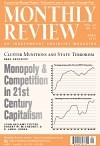Volume 62, Issue 11 (April)

This year marks the forty-fifth anniversary of the publication of Paul Baran and Paul Sweezy’s classic work, Monopoly Capital: An Essay on the American Economic Order (Monthly Review Press, 1966). Three years before the publication of their book, in the July 1963 issue of Monthly Review, Baran and Sweezy published two chapters of Monopoly Capital in MR, together with an introduction. (The publication of the actual book was delayed by Baran’s death in 1964.) Today MR editor John Bellamy Foster and Robert W. McChesney are currently completing a book, entitled Monopoly-Finance Capital: Politics in an Era of Economic Stagnation and Social Decline, to be published by Monthly Review Press early next year. The purpose of this new work is to bring the analysis of Monopoly Capital up to date, addressing the changes that have occurred in the capitalist system in the last half-century. We have therefore decided to follow the example of Baran and Sweezy and publish a number of the core chapters of this book, in early form in the magazine, in advance of the book itself. The March 2011 Review of the Month, “The Internet’s Unholy Marriage to Capitalism,” was one such chapter. This issue’s Review of the Month, “Monopoly and Competition in Twenty-First Century Capitalism“…is another. | more…
A striking paradox animates political economy in our times. On the one hand, mainstream economics and much of left economics discuss our era as one of intense and increased competition among businesses, now on a global scale. It is a matter so self-evident as no longer to require empirical verification or scholarly examination. On the other hand, wherever one looks, it seems that nearly every industry is concentrated into fewer and fewer hands. Formerly competitive sectors like retail are now the province of enormous monopolistic chains, massive economic fortunes are being assembled into the hands of a few mega-billionaires sitting atop vast empires, and the new firms and industries spawned by the digital revolution have quickly gravitated to monopoly status. In short, monopoly power is ascendant as never before. | more…
For decades, major global and regional powers have waged war against those they accuse of fighting immorally—that is, those who use terrorism to harm civilians at home and abroad. Paradoxically, these righteous “wars on terror” are being fought in an era in which the distinction between war waged only against soldiers, and war against soldiers as well as civilians has virtually collapsed. The technological development, stemming from the Industrial Revolution, of aerial bombardment and weapons of mass destruction has made it more difficult to separate citizen from soldier.… [but] it is imperative that this distinction hold. In waging wars on terror, [upholding the soldier/citizen distinction] permits globally powerful nations to rally public opinion under the assertion that what separates us (self) from them (other) is that civilian life is paramount for us and not for “the terrorists.” | more…
On March 25, 1911, a fire spread through the seventh, eighth, and ninth floors of the Triangle Shirtwaist Factory in New York City’s Greenwich Village. The mostly immigrant workers, young Italian, Jewish, and German women who sewed shirtwaists, or women’s blouses, were trapped behind locked doors. The death toll was 146, and many women, their clothing and hair burning, threw themselves from the windows to their deaths on the pavement far below, while spectators watched and could not help. Shortly thereafter, twenty thousand women struck for improved working conditions and wages. The factory building is now part of New York University. The Triangle Shirtwaist Factory Fire remains the fourth largest industrial disaster in U.S. history. | more…
Julius Rosenberg’s Decidedly Political Decision
I would like to expand on a couple of areas from Staughton Lynd’s thought-provoking essay (“Is There Anything More to Say About the Rosenberg Case?” MR, March 2011) on the case of my parents, Ethel and Julius Rosenberg. Though Staughton is too modest to “have a go” at the validity of the analysis presented in Walter Schneir’s Final Verdict, I think it is important to note that unlike the authors of Venona, whose work is quoted in the article, Schneir is the first writer to take the most recently released materials from the former Soviet Union and subject them to a close analysis in comparison to what we had always “believed” we knew about the case. | more…
Michael Lim Mah Hui and Lim Chin, Nowhere to Hide: The Great Financial Crisis and Challenges for Asia (Singapore: Institute of Southeast Asian Studies, 2010), 200 pages, $39.90, paperback.
Nowhere to Hide by Michael Lim Mah Hui and Lim Chin is another book on the financial crisis, although with added attention to Asia. In addition to the regional implications of the crisis for Asia, what makes this volume different from so many others is its critical perspective.… The book thus reflects an insider’s view of the banking system that is informed by a critical, political-economic perspective. As such, Nowhere to Hide makes a good companion to Monthly Review’s own The Great Financial Crisis by John Bellamy Foster and Fred Magdoff. Indeed, there is a close connection between these works, symbolized by the incorporation of Foster and Magdoff’s title into the subtitle of Nowhere to Hide. | more…
